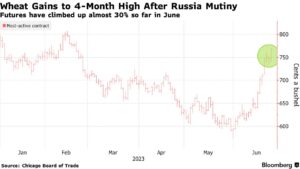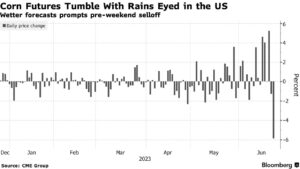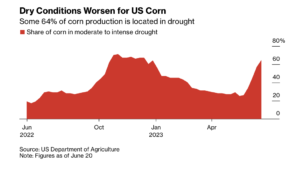Beef prices are projected to continue increasing as U.S. beef production declines with no signs of a cattle herd rebuild. Additionally, cheap beef may soon become further out of reach…
Wheat Climbs Amid Russian Turmoil, as Heat Wave Impacts Agriculture in China
Bloomberg writers Jasmine Ng and Megan Durisin reported today that, “Wheat climbed to a fresh four-month high after the armed uprising in top exporter Russia added uncertainty over the outlook for grain shipments from the Black Sea breadbasket.

“Russia is expected to be the world’s biggest wheat exporter this season and next, and any shift in its shipments would have a significant impact on global flows. There doesn’t appear to be immediate disruptions to its wheat trade, although the shipping industry will be assessing the safety of operations in the region, said Carlos Mera, head of agricultural commodities market research at Rabobank.
Wheat futures in Chicago rallied as much as 3.2% as traders weighed the implications of the weekend events. The advance puts prices on track for a 29% monthly gain, the biggest since 2015, which has also been driven by dry weather parching US corn and soy crops.
The Bloomberg article added that, “The situation could add to worries over the future of the pact that allows to Ukraine to ship grain from Black Sea ports. The deal is up for renewal in mid-July and Ukraine’s infrastructure minister last week said he was ‘not optimistic’ over its extension.”

Meanwhile, Bloomberg writer Michael Hirtzer reported on Friday that, “Corn futures tumbled Friday as traders exited positions amid a wetter outlook for the US crop that has been suffering under drought conditions.
“Corn for December delivery sank 5.9%, the biggest one-day loss in the contract’s history. Soybeans and wheat also fell.
“Weather models showed better chances for precipitation during the next 14 days — a critical time of development when plants will start their yield-determining pollination phase. Meanwhile, a lack of export demand for US grain further pressured corn futures, which earlier this week jumped to the highest levels since October.”

Reuters writer Mark Weinraub reported on Friday that, “The latest weather projections pointed to significant rain in parts of the Midwest in the week ahead, which analysts said could bolster the condition of crops before key growth stages this summer.”
And yesterday, Bloomberg writer Sophie Caronello reported that, “Crop conditions in the US, the world’s largest corn producer, are deteriorating as dry weather spreads across key growing areas. Corn crops experiencing moderate to intense drought have increased to 64% of the total, jumping 39 percentage points in the past five weeks. That compares with just 19% for the same week a year ago. Market watchers will get a fresh sense of the state of the Corn Belt with the release of crop conditions on Monday and the weekly drought report on Thursday. The most recent report showed the situation worsened more than anticipated as a lack of rain stressed young plants. Still, amid the darkening outlook, heavy profit-taking pushed corn for December delivery to fall 1.6% last week in Chicago after a recent surge had technical indicators suggesting the runup went too far, too fast.”

And today, Reuters writer Naveen Thukral reported that, “Chicago corn futures slid for a third consecutive session on Monday to their lowest in one week, as forecasts for beneficial rain in the U.S. Midwest weighed on prices.”
7-Day Total Precipitation Outlook, June 26th to July 3rd. pic.twitter.com/WUbu8ok8ZP
— FarmPolicy (@FarmPolicy) June 25, 2023
July 1st to July 5th Outlook. pic.twitter.com/8EeZUWKwVM
— FarmPolicy (@FarmPolicy) June 25, 2023
Elsewhere, Nicole Hong reported in Sunday’s New York Times that, “The downpour began in late May, drenching the wheat crops in central China. As kernels of wheat blackened in the rain, becoming unfit for human consumption, the government mobilized emergency teams to salvage as much of the harvest as possible. In a viral video, a 79-year-old farmer in Henan Province wiped away tears as he surveyed the damage.
“The unusually heavy rainfall, which local officials said was the worst disruption to the wheat harvest in a decade, underscored the risks that climate shocks pose to President Xi Jinping’s push for China to become more self-reliant in its food supply.
“Ensuring China’s ability to feed 1.4 billion people is a key piece of Mr. Xi’s goal of leading the country to superpower status. In recent years, tensions with the United States, the coronavirus pandemic and Russia’s war on Ukraine have all created more volatility in global food prices, heightening the urgency for China to grow more of its own crops.”
Reuters writer Ryan Woo reported on Saturday that, “Beijing topped 40 degrees Celsius (104F) on Saturday for a record third day as the Chinese capital sweltered in extreme heat, while uncommonly high temperatures for June grilled an area the size of California in northern China.”
On Sunday, Bloomberg writer Hallie Gu reported that, “A heat wave in northern China is the latest threat to agricultural production in the country as the El Nino weather pattern brings hotter and drier conditions than normal.”
The Bloomberg article noted that, “The extreme temperatures and low rainfall are expected to continue in northern China this week, the National Meteorological Centre said in a report on Monday. That could impact the output of crops including wheat, corn, soybeans and cotton.
“The heat is affecting the growth of corn and soybean crops in parts of northeastern China, the weather center said in the report. It could also hinder timely planting of summer corn, lead to more diseases from pests, was well as disrupt cotton output from the Xinjiang region in the the northwest, it said.”
And Reuters writer Dominique Patton reported yesterday that, “About 3 million hectares of farmland in China are suffering from drought, state media reported on Sunday, after record high temperatures hit a large part of the country’s north since last week.
“About 200,000 people and 760,000 large livestock do not have access to sufficient water, Xinhua reported, citing the Ministry of Water Resources.
“The affected areas are mainly the northwestern region of Inner Mongolia, known for its grasslands that feed sheep and cattle, as well as northern Hebei province and northeastern Liaoning, both important corn and dairy farming areas.”





